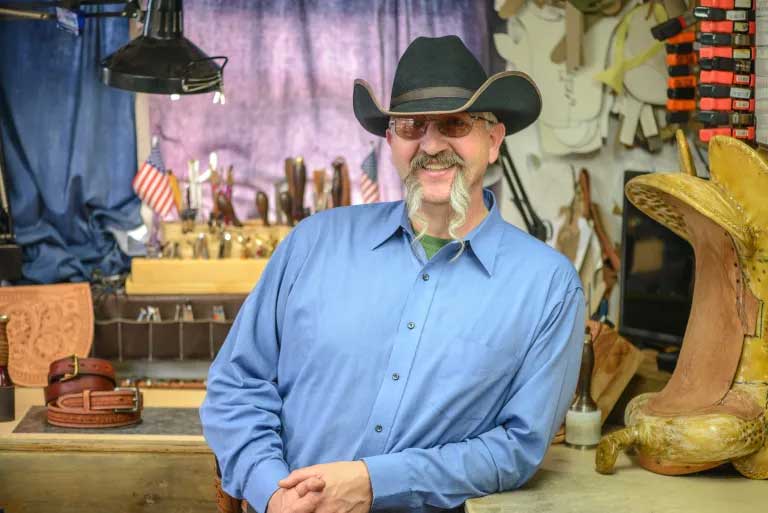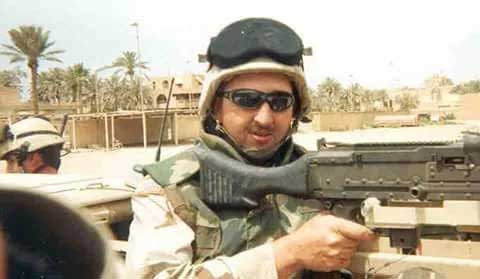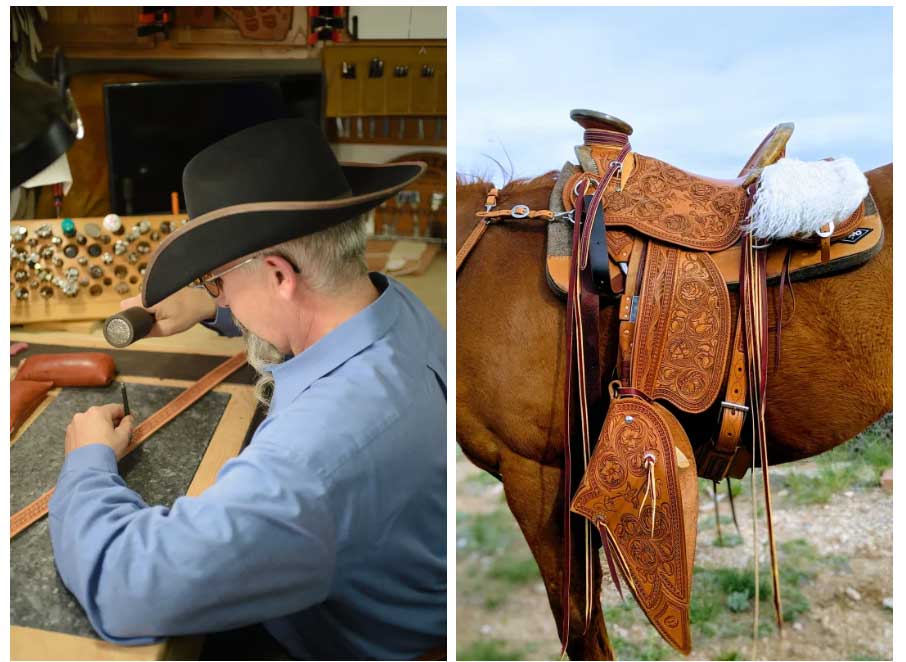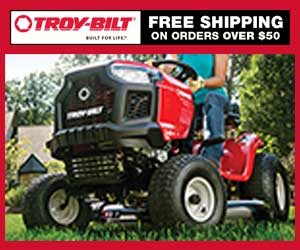
By Nick Pernokas
In the days of the old west, it wasn’t unusual to see someone who had more than one occupation. In remote areas, it was helpful if a man was able to do more than one thing. Leather was an important trade, so in many cases it overlapped with other jobs. Kit Carson fixed harness, when he wasn’t acting as a military guide. S.D. Myres was a mayor and a deputy sheriff.
Now, I want to tell you about Davis Reynolds.
Davis grew up in Louisiana. His uncle, Bud Moses, was a stock contractor and on weekends Davis would work for the rodeo company.
“I worked for him for years,” says Davis. “It was a blast.”
In 1990, about the time he got out of high school, Davis started riding bulls and roping calves and steers.
“I’d ride bulls and team rope, but whenever I got hurt, I’d go back to team roping.”
In 1994, Davis moved out to the Grand Canyon area to cowboy, and quit riding bulls because there wasn’t much bull riding near there. Day working on some of the local ranches replaced the team roping. Davis worked for the Babbitt Ranches during their month-long roundups. The Babbit Ranches were huge and still ran a chuck wagon.
“Those guys were just awesome. They took me under their wing and took me out there.”
The vastness of the Babbitt Ranches impressed Davis. The endless panorama of sky and emptiness was a change from Louisiana.
Davis went to work as a tour guide for the mule concession in the Grand Canyon National Park. The mule barn had its own saddle shop and Davis built some chaps for himself. One of his friends there was a saddlemaker and he suggested to Davis that they build a saddle for him.
“I helped him build my first saddle,” remembers Davis. “It was terrible, because it just gave me the bug.”
From then on, Davis built all of his own gear.
In 1995, Davis married Lisa, who he met at the mule barn. In 1997, the park service was looking for someone to pack supplies into the Phantom Ranch at the bottom of the Canyon. Davis had the experience, so he went to work for the Park service. It was a federal job with the Department of the Interior.

In 2000, Davis joined the Arizona National Guard. After 9/11, he was deployed overseas to Iraq for six months, where he participated in special missions. Davis was the medic in his team. A knee injury caused him to be sent to Germany for surgery. When Davis returned to the United States, he received a medical discharge. Unfortunately, something else had followed him home: PTSD.
Davis discovered that his leatherwork was good therapy, and he began a successful leather cell phone case construction business in a camper next to his house. Soon, his nightmares were going away. Davis was making a lot of hand-sewn cases, but he wanted to build other products as well. Davis found out that he was eligible to attend a leather trade school through vocational rehabilitation, and the G.I.Bill, if he could jump through all the hoops to qualify.
After several months of completing other courses in business, Davis was cleared to find a saddlemaking instructor. The stipulation on this was that it had to be someone who had worked for vocational rehabilitation and had taught other veterans. Davis searched the western United States and finally found Bud Shaul, a saddlemaker in Yarnell, Arizona. Bud, a marine, had taught veteran classes at a school in Idaho. Bud was also a former saddlemaker at Hamleys Saddlery in Oregon.
Davis told Bud, “I want to learn about saddles, but for anything you do in this shop, I’m yours.”
Davis took two of Bud’s two-week classes on saddle construction. In the process he built two saddles, but more importantly, the men became friends. There wasn’t any place to stay that was close, so Davis slept in Bud’s shop and did some repair work for him at night. Bud was impressed with Davis’s work ethic and his eye for detail. When the classes were over, he offered Davis a job, which was more like an apprenticeship. There was no pay involved, but the opportunity to learn was tremendous. For the next two years, Davis would travel down to Yarnell on his weekends and vacations from the Park Service at the Grand Canyon.
Davis helped out at Bud’s schools and met many other vets that were coming through it. Eric Marsh wasn’t a vet, but he was a firefighter who took the class. Eric asked Davis for help on a saddle he was building after he took the class, but soon after he tragically perished as a Hotshot fighting the Yarnell Fire. Eric’s widow called Davis and asked him to finish Eric’s saddle, which he did.
Davis Reynolds Saddlery now had a 12×24-foot building and things began to pick up for him.
“I was happy. I’m thinking, I’m a hobbyist doing what I love to do in my off time. Then, I realized the responsibility you have when you’re making that stuff.”

Davis decided that to make a top-quality product, he had to learn from more experienced leather workers. Bud encouraged him to take some classes. Davis was hesitant at first, but Bud even offered to go to some classes with him.
Bud told Davis, “As long as you’re alive, you need to take lessons from other people and swallow your pride.”
Davis went to the Wickenburg Leather Show that was put on by The Leather Crafters and Saddlers Journal. The friends and connections he made there were priceless. He met people that he could call if he had a question. For the next few years, Davis took classes at the show.
“It was the coolest thing to meet some of the greatest leather artists in the world there.”
Davis became good friends with Charil Reis and Ralph Solome, who managed those shows, and now he works for them at the Prescott and Sheridan shows. He hands out the informational packets at the door and helps people find the tools that they need.
“I get so much energy off of that, helping other people find that drive and keep that drive going. There’s so much talent at these shows.”
Bud passed away before fulfilling his dream of enlarging his school. The family sold most of his equipment through an estate sale, but they gave Davis all of his patterns and books. Many of the patterns are the old Hamley patterns. The northwest look has definitely influenced Davis’s style.
“The round skirts have drawn me to a lighter, stronger saddle with inskirt riggings.”
Davis uses a variety of swells. His favorite is a Flat Creek Packer, which has a little swell to it. It’s similar to an Association swell with a wood post horn.
“To me, a saddle is that person’s personality, not mine. You have to make it to match their personality and what they want it to look like.”
Since Covid, Davis’s saddle orders have dramatically increased. Davis also builds a lot of holsters, which range from concealed carry to cowboy style. Cobra sewing machines have replaced the stitching pony in his shop.
Today, Davis runs the sign shop for Grand Canyon National Park. They produce all of the informational signs in the park. On his time off from the park service, Davis also works as a hunting guide for Steve Chappell of Elk Camp T.V. Elk Camp is a weekly show on the Sportsman Channel. Their team schedules elk hunts in the high desert of Northern Arizona during hunting season for various individuals and then films them.
Davis and Lisa have 40 acres just south of the park with a log home and the shop. A couple of older horses share their place with them. Davis seems to keep things fresh by all of his varied professions he rotates between. As if that weren’t enough, Davis is licensed to marry couples. He has even performed weddings in his shop. That’s what I call a full-service saddlemaker.
You can find Davis Reynolds Saddlery on Facebook.
Photographs Courtesy of Reynolds Saddlery
This article originally appeared on Shop Talk Magazine and is published here with permission.
There are more interesting articles in our section on Recreation & Lifestyle.
































